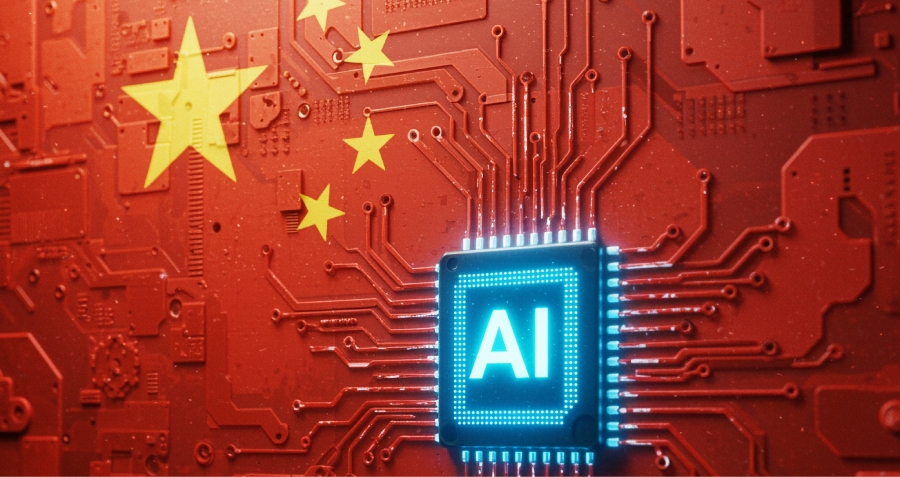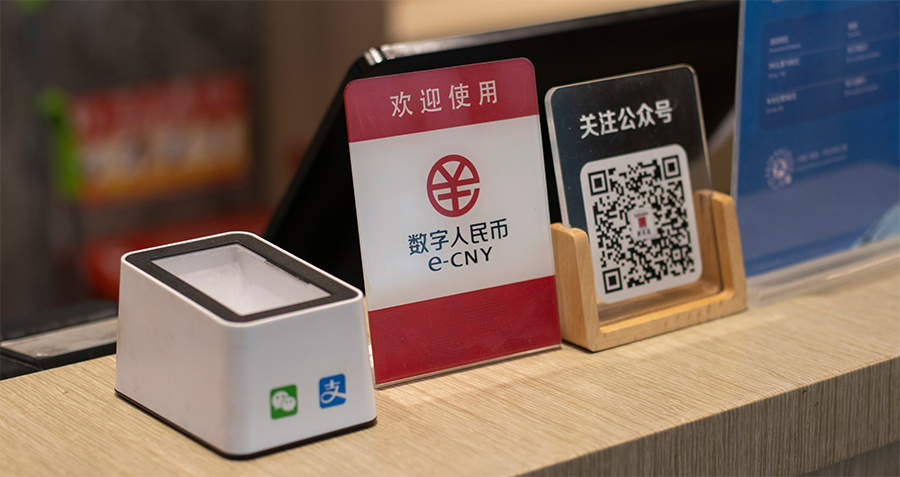The sudden emergence of DeepSeek’s latest large language model in early 2025 sent waves through the global artificial intelligence community, shifting the common understanding of the limitations of AI development. The R1 model not only outperformed almost all of its competition, but did so at a lower cost, requiring less staff and with less advanced physical technology behind it. The implications of the latter was so notable that it caused leading AI chipmaker Nvidia’s stock value to initially drop by 20%.
Despite the rapid development of AI models over the past few years, the sector is still young and options for iteration and innovation are almost limitless. China is looking to play a key role in AI advancement globally, and both the country’s government and its private enterprises are pushing hard to keep at the leading edge.
“China’s AI has moved very fast and shifted from “following” to partially “innovating” over the last five years,” says Adina Yakefu, a China AI expert at machine learning platform Hugging Face. “For instance, DeepSeek has amazed the world with its reasoning model DeepSeek R1, which is not only cost effective but also open source. There have also been many other achievements in natural language processing (NLP), computer vision, Multimodal Large Language Model (MLLM) and robotics research.”
China’s AI ecosystem
While China’s economy is to a large extent dominated by the state, private enterprise has been a key driver of China’s AI progress, with the country’s tech giants and a vast range of rapidly expanding startups adding their contributions. Tencent, ByteDance and Alibaba are familiar faces in China’s tech landscape, and are all pushing heavily into the AI sphere.
Utilizing their significant financial resources, computational power and access to top talent, they have made notable progress in not only training AI models, but also developing AI infrastructure.
“The big platforms are focusing on incorporating AI tools into their existing service offerings,” says Tilly Zhang, China technology analyst at China macro research firm Gavekal Dragonomics. “For example, Tencent are adding AI to their games, while Baidu and Alibaba are building out AI-powered cloud services. They have different strategies, but generally are willing to spend huge amounts of money on AI.”
Startups are the other key private sector component to China’s burgeoning AI wave, providing a more diverse exploration development options. These companies are smaller, more flexible and not limited by existing organizational structures, often becoming more innovative as they search for a way to differentiate themselves in the market.
DeepSeek is the best known of the startups, with its R1 model showing that many of previously perceived barriers to entry to AI development were not set in stone. But what really underscores the depth of China’s AI startup ecosystem is that DeepSeek is, as of yet, not on the list of “Six Tigers” that are seen as the leading edge of China’s AI industry.
Zhipu AI, MiniMax, Baichuan Intelligence, Moonshot, StepFun and 01.AI make up the list, and the firms offer a variety of generative AI models, covering text, audio and image generation, as well as more targeted applications.
“Both startups and tech giants are driving the AI revolution in China, each leveraging their unique strengths to push the boundaries of what AI can achieve,” says Yakefu. “The synergy between these two groups is fostering a dynamic and rapidly evolving AI landscape in the country.”
The Chinese government has also been a clear proponent for AI development, providing strategic, infrastructural and governance support, particularly since the introduction of the AI Next Generation Artificial Intelligence Development Plan in 2017 and the AI+ initiative in 2024.
“On the infrastructure front, China has launched initiatives like the National Computing Power Network and the East Data West Computing Project, which aim to optimize resource allocation and enhance computational capabilities,” says Yakefu. “Additionally, the country is actively building intelligent computing clusters in cities like Beijing and Shanghai to foster industrial growth and create an active AI ecosystem.”
Government-related organizations are investing billions of dollars annually to support AI research, application development and innovation, as well as acting as customers for the finished products. Precisely what the system is doing internally in terms of military or other AI projects is unknown.
“SOEs such as China Mobile and China Telecom are buying AI models and solutions for both internal and external use, and the government is also making purchases for public sector services,” says Zhang. “Out of all the generative AI investment deals since 2020, the Chinese government has participated in more than 60% of them.”
AI industry implementation
China’s adoption of AI, particularly following the introduction of the AI+ initiative, spans various industries as well as daily life. There has been the development of smart city initiatives in many urban areas, using AI to optimize traffic management, air quality monitoring and governance efficiency. AI is also driving down costs in the manufacturing sector, with a view to developing intelligent and autonomous factories as part of the Industry 4.0 upgrade.
Another area that stands out is the auto industry. “Li Auto repositioned itself as an AI-focused high-tech company in early 2025, while Geely Automotive has collaborated with StepFun to release 2 open MLLMs and announced the “Qianli Haohan” smart driving system,” says Yakefu.
China’s consumer internet industry already had a solid technological foundation prior to the growing use of LLMs and there has been a proliferation of AI-powered apps from major players for music generation, education, customer support and many others.
“It is mostly a process of testing the market at the moment,” says Zhang. “AI-specific apps have millions of users, but they are not paying a lot for the services and companies need to work out where the demand lies.”
Healthcare is another industry where AI plays a substantial role with companies such as Baichuan Intelligence partnering with hospitals to provide AI “doctors” that assist with diagnosing and treating complex diseases.
The DeepSeek impact
While we have already seen several different applications for AI across a variety of industries, what comes next is hard to tell. However, the release of DeepSeek provided a greater spark of potential for the future.
There have been three key stages of AI development: the pre-LLM era that came before ChatGPT’s release in 2022; the proliferation of large language models (LLMs) between 2022 and late 2024; and now the post-DeepSeek era. The R1 model changed the game by producing results that are competitive with leading global alternatives but using fewer people, fewer and less advanced resources and at a fraction of the cost.
“Prior to DeepSeek companies had to consider a number of barriers in terms of integrating AI into their practices,” says Larry Cao, an author, researcher and speaker specializing in the integration of AI and big data in finance. “Cost, talent, challenges related to evolving technology such as rapid obsolescence, management vision and development time were all issues that proved difficult to overcome.”
But, seemingly out of nowhere, DeepSeek sidestepped these issues. The model’s existence is proof of a clear management vision within the company and the innovative nature of the technology meant that time lag behind competitors was a non-issue.
“The model is low cost and was developed by a small team of Chinese talent that defied conventional expectations,” adds Cao. “It is often presumed such breakthroughs require a degree from a top Western university and experience at a major Western tech firm, yet the largely homegrown team managed to find a way to deal with algorithm and technology hurdles that many would have presumed to be beyond them.”
DeepSeek, along with a growing number of other AI models, is open source—meaning that the software’s source code can be inspected, modified or enhanced by any user. Given this ease of access, open source models are significantly more cost effective for developers, many of whom are unable to afford closed source products.
“Google’s chief scientist Jeff Dean has discussed the importance of technology diffusion at scale, as opposed to who has the ‘best’ technology, as a key factor in commercialization and growing GDP contribution,” says Zhang. “This is what makes open source so important, because it makes deployment at early stages and across more industries much easier. China has a real opportunity to make the most of this in particular.”
While many AI projects were already open source prior to DeepSeek, the company’s success has pushed the developers of major closed source models to either shift to open source or make their products free in order to remain competitive.
“Some of the earliest and most influential startups in the China AI space have adopted open-source strategies,” says Yakefu. “MiniMax, with its Hailuo AI, and Moonshot AI, with chatbox Kimi, have been highly active in the market. Both companies have recently started engaging with the open-source community by releasing their models on Hugging Face [a platform used for sharing and collaborating on open source AI models].”
The race to first place
Although it was revolutionary in many ways, surpassing domestic competitors such as Alibaba’s Qwen, DeepSeek still has its drawbacks and that is reflective of a similar lag in some areas of China’s AI progress compared to global counterparts such as OpenAI’s ChatGPT.
“If it’s just capability, then China is about a year behind the best US model,” says Zhang. “DeepSeek is a good product but not as comprehensively well trained when looking at the sources used in its testing. But in terms of using AI, China is competitive, just with a different focus to the US. China was very strong in the pre-LLM era, but is finding it a little harder to keep up in the generative AI era.”
China still faces challenges in foundational R&D capabilities, particularly in terms of talent acquisition. At the same time, restrictions on access to high-end chips or other hardware are likely to continue to pose obstacles.
“In addition, research and frameworks related to AI safety, governance, and ethical considerations still have room for further development,” says Yakefu. “This gap in addressing the societal and moral implications of AI could certainly impact the industry’s growth and direction.”
Some companies have already attempted to offset impacts on employment to some degree, including Baidu, which, under pressure from the Chinese government, offered taxi drivers roles in remote monitoring their robotaxis, in order to replace the driving work that they might lose. But outside of the development of the technology itself, working out how to deal with the impacts of AI replacing humans in the labor force and who is going to benefit from the associated cost savings, is a pressing issue for both businesses and governments.
“With the speed of research into AI increasing, it is getting harder to predict who will be affected and to what degree,” says Cao. “But it will clearly be a massive issue and there are questions that are yet to be answered. Who will own the AI? How will the wealth be distributed if more people are out of work? It will be dangerous if AI is only owned by a few people.”
New compensation structures have been theorized, including suggestions that companies set up technological social security funds, where the costs saved by AI solutions should go to those who have had their salaries reduced or lost their jobs. But there has not been much concrete progress in the area.
The AI sky is the limit
It is difficult to predict what will come next with AI due to the relative immaturity of the technology, coupled with the sheer scale of potential applications. But it is already clear that LLMs are now able, to varying degrees, to understand text, images, audio and video, which are the fundamental building blocks of any future applications including intelligent manufacturing, smart vehicles and embodied intelligence.
“The sky’s the limit for what can be done with AI,” says Cao. “We are at an early stage, so we don’t fully understand what can be done, it really just depends on where companies or developers choose to focus.”





















